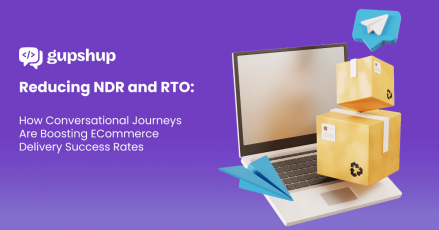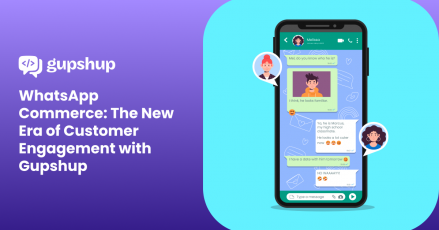SMS API Service: A Comprehensive Guide

When everything goes offline, like during a city-wide power outage, what is the one thing most companies can rely on to send a message across? SMS.
Here’s a situation of SMS API integration at work – your internet’s down, apps stop refreshing, but then you get that one text from your internet provider:
| Internet services are down in your area. Crews are working to restore service. Estimated restoration: 2 hours. |
That’s the beauty of SMS APIs. No Wi-Fi? No problem. They still get the message through. But here’s the misconception that needs to be cleared: SMS isn’t just for emergencies.
Businesses are using the SMS API service to do the heavy lifting every day.
- Order confirmations? Delivered instantly.
- Shipping updates? Right in your pocket.
- Sales reminder? It’s got you covered.
With an open rate of 98%, you can bet those texts are being read, unlike emails that just collect dust in inboxes.
SMS APIs scale without breaking a sweat and send thousands of messages instantly. From promotional offers to service updates, companies can automate everything, reducing the need for manual labor while keeping customers engaged in real-time. It’s fast, reliable, and keeps communication flowing no matter what.
In this article, we will talk about SMS API service and how you can use its full potential to keep customers engaged and increase sales at the same time.

Understanding SMS API
When it comes to business communication, reliability, and control are key. As a business, when you send out a message about anything, be it notifications, order confirmations, or updates, you want to reach your customers without any obstruction. That’s where SMS API service shines.
Basically, SMS API is a powerful yet simple tool that allows your app or software not only to send but also receive text messages without any manual effort. It integrates seamlessly with your applications, letting you automate your messaging and get it delivered at the right time.
No more second guessing, no more hoping it reaches the right person, just direct, reliable communication every single time.
Technical breakdown – How does an SMS API communicate?

SMS API communicates by connecting your application with an SMS gateway.
Let’s say your brand needs to send a confirmation message after someone places an order. Here’s how the SMS API integration will help –
- Request sent: The app starts by sending a message request to the SMS API. You don’t have to do anything manually; the API takes care of sending that text.
- API processing: Once the request is in, the API gets to work. It takes the message you want to send and converts it into a format that telecom networks can understand. Think of it as translating between your app and the mobile carriers.
- Message delivery: Now, the API passes your message along to the mobile carrier, which then delivers it to the recipient’s phone. It doesn’t matter if you’re sending one message or 10,000—the API becomes your bulk SMS solution.
- Status update: The API then tracks the whole process and lets you know whether the message was delivered, delayed, or failed. You’ll always know what’s happening, no guessing is required.
Did you know that an SMS API can handle messages in various formats, from simple plain text to rich media like HTML and MMS? It also supports multiple languages and alphabets, so you can communicate with customers worldwide without any excess hassle!
Benefits of SMS API

When it comes to customer communication, you need speed, reliability, and reach, this is where an SMS API service delivers big. Here’s why businesses rely on it:
- Efficiency and speed: Forget manual messages. An SMS API lets you send updates, OTPs, and also confirmations instantly, in real time, without lifting a finger.
- Better visibility: Emails can get lost in spam, but SMS reaches inboxes, ensuring your messages get seen.
- Automation and reliability: With automation, you never worry about missing a message because the API sends texts exactly when needed, tracking delivery so you know they’re received.
- Global Reach with high delivery rates: Bulk sms messaging API can connect with customers across borders, ensuring your texts are delivered promptly and in bulk, regardless of where they are.
- Scalability: Whether you’re sending to 10 or 10,000 customers, SMS APIs can scale easily, delivering every message with the same consistency.
- Cost efficiency: You don’t need costly infrastructure. SMS API integration streamlines communication, saving time and money while boosting efficiency.
- Easy integration: SMS APIs fit seamlessly into your existing tools, whether it’s your CRM or website, simplifying communication with fewer errors.
- Advanced Features and Flexibility: Beyond simple texts, SMS API service lets you schedule messages, engage in two-way conversations, and also send multimedia content.
Real-World Applications Across Industries

Let’s look at some real-world applications of SMS API across several industries –
Banking
Banks rely heavily on SMS API service for secure and immediate communication with customers. Whether it’s sending a one-time password (OTP) for two-factor authentication or alerting customers about suspicious transactions, SMS ensures that important updates are delivered instantly. Overall this adds an extra layer of security and transparency to financial operations.

Healthcare
Similar to Banking, SMS API plays a vital role when it comes to ensuring timely communication in the Healthcare industry as well. Right from sending automated appointment reminders till follow-up messages after a visit, it helps reduce no-shows and enhances patient engagement.

E-commerce
Firstly, SMS API integration is critical for keeping customers informed about their orders. They allow e-commerce platforms to send real-time updates on order confirmations, shipment tracking, and also promotional campaigns to drive sales. This helps improve the overall customer experience and retention.

Travel
Travel companies use SMS APIs to keep passengers informed about booking confirmations, and flight delays, and also to send real-time itinerary updates. Undoubtedly, this ensures smooth communication and helps travelers manage their journeys more effectively.

Education
Educational institutions leverage SMS API services to communicate efficiently with students and parents. For example, they use SMS to send out fee reminders, and additionally, they notify parents about important events. Moreover, this timely and effective communication plays a crucial role in maintaining smooth operations.

Best SMS marketing campaign strategies in 2024
Here are some SMS marketing strategies that your company could use in the upcoming campaigns –
1. Make sure people actually want to hear from you
Before you even think about hitting send, make sure your audience has opted in. Asking for permission builds trust and keeps you out of legal trouble. Encourage sign-ups with clear offers: “Text ‘DEALS’ to 12345 for weekly discounts.” And don’t forget, an easy opt-out option like “Reply STOP to unsubscribe” keeps you on the right side of your customers (and the law.)
2. If it’s not personal, it’s not worth it
People tend to ignore generic messages; however, using what you know about them, such as past purchases or birthdays, can make your texts more engaging. For example, a birthday discount or a product suggestion based on their last order demonstrates personalization. Ultimately, these tailored messages show customers that you value them as individuals rather than treating them as just numbers.
3. Urgency drives action, so use it
“Limited time only” is your best friend when it comes to SMS. Texts with words like “Today Only!” or “Ends at Midnight” create a sense of urgency that pushes customers to act. When time’s ticking, people pay attention.
4. Let automation do the heavy lifting
You can’t send every message yourself. That’s where automation comes in. From abandoned cart reminders to post-purchase follow-ups, automated texts keep your customers engaged while keeping your effort minimal. Set it up once, and let it run in the background.
5. Start a conversation, don’t just blast messages
SMS isn’t just a one-way street; instead, it’s an opportunity to foster meaningful dialogue. For instance, you can allow customers to respond to your messages by asking questions, providing feedback, or engaging with customer support. Moreover, enabling two-way conversations helps build trust and ensures that customers feel valued and heard.
6. Timing is everything, don’t send a text at 4 AM
Firstly, nobody wants to wake up to a sales text in the morning. Find the sweet spot in your customers’ day, mid-morning or late afternoon typically works best. And always localize send times to match their time zone for maximum impact.
7. Keep it fun, boring texts lose customers and their interest
SMS is personal and informal, so have some fun with it. Use polls, trivia, or even GIFs to keep your customers engaged. When texts are entertaining, people are more likely to open and interact with them.
8. Give them VIP treatment
Exclusive offers keep customers loyal. Reward your SMS subscribers with early access to sales, members-only discounts, or sneak peeks of new products. When they feel special, they stick around.
9. Track everything and improvise
Your SMS marketing isn’t one-size-fits-all. Track what works, open rates, clicks, and conversions, and test different messages to see what gets the best response. Tweak your strategy based on data, and keep improving.
10. Tie SMS into everything else
SMS shouldn’t stand alone. Use it alongside email, social media, and other channels to create a consistent experience for your customers. If you send an email about a sale, follow up with a text reminder. Keep everything connected.
How to Create an SMS API with Gupshup
Now that you know how important setting up an SMS API is, here is how Gupshup can come in handy.
Gupshup is a leading conversational messaging platform that allows businesses to automate communication across SMS and other channels like WhatsApp and RCS. With its scalable API, Gupshup enables businesses to engage customers through secure, two-way conversations, OTP verifications, notifications, and more, reaching over 7 billion messages per month.
Step-by-step setup
Step 1: Create a Gupshup account
- Sign up: If you don’t have an account, go to Gupshup’s website and create one. To get started, you’ll need to provide basic details like your email, password, and phone number.
- Log In: Once your account is created, log in to access your dashboard.
Step 2: Generate your API key
- API Key Creation: After logging in, navigate to the API section of your dashboard. Here, you’ll find the option to create a new API key. This key is crucial for authenticating your application.
- Save the API Key: Once generated, securely store your API key, you’ll need it to send messages through your API.
Step 3: Configure the API for your application
- Choose the use case: Decide what you’ll be using the SMS API for, whether it’s transactional messages (like OTPs), marketing promotions, or notifications.
- Create an App ID: Go to the “Create App” section in Gupshup and provide an app name. This will create a unique App ID associated with your API.
- Configure the API URL: The API request URL will look something like this:
| https://api.gupshup.io/sms/v1/message/appid |
Step 4: Send your first SMS
- Write the request: Here’s an example of a cURL request for sending an SMS:
| curl –location –request POST ‘https://api.gupshup.io/sms/v1/message/:appid’ \
–header ‘Authorization: Bearer YOUR_API_KEY’ \ –data-urlencode ‘destination=91XXXXXXXXXX’ \ –data-urlencode ‘message=Your OTP is 123456’ \ –data-urlencode ‘source=GUPSHUP’ |
Step 5: Test the integration
- Sandbox testing: Gupshup provides a sandbox environment to test your messages before going live. This is useful for making sure everything works without sending messages to real users.
- Whitelisting numbers: For testing, you might need to whitelist specific numbers to simulate the SMS sending and receiving process in the sandbox.
Step 6: Monitor delivery and reports
- Real-time delivery reports: Use the Gupshup dashboard to track delivery reports and message statuses like sent, delivered, or failed. Gupshup also supports webhook integration to get these notifications in real-time.
Step 7: Scale up
- Bulk messaging: Once everything is working, you can scale your SMS sending to include thousands of messages using Gupshup’s bulk messaging features.
- Automation: Automate reminders, marketing campaigns, or OTPs to engage your customers efficiently.
Conclusion
While everyone’s busy chasing likes and shares, SMS quietly delivers results with an open rate of 98%. Think about it, almost every single text message probably gets opened. Compare that to email, where only about 20% even get looked at, and suddenly, texting looks a lot more powerful.
The beauty of SMS API service is its simplicity. And in fact, everything lands right where it needs to be: in your customer’s hands. Whether it’s confirming an order or sending out a flash sale alert, SMS API does all the heavy lifting without you having to lift a finger. It’s fast, scalable, and gets the job done.
Integrating an SMS API is like flipping on autopilot for your communication. And because texts aren’t getting lost in a spam folder or drowned out by algorithms, SMS is where your marketing can break through all that noise.
SMS isn’t just hanging around in the background anymore. It’s your front-line tool for real-time engagement. Get it right, and you’ve got yourself a powerful tool for staying connected with your customers in a way that’s immediate and effective.
Frequently Asked Questions (FAQs)
1. What is an SMS message service?
SMS (Short Message Service) allows businesses and individuals to send and receive short text messages (up to 160 characters) between mobile devices. It’s a highly reliable communication tool that offers direct and instant messaging and is commonly used for notifications, alerts, and promotional messaging.
2. What is the difference between SMS Gateway and SMS API?
An SMS Gateway acts as a bridge between your application and mobile carriers, translating your messages into a format that networks can deliver to recipients. Meanwhile, an SMS API is an interface that allows your software to connect to an SMS Gateway, automating the process without manual input.
3. How to make SMS API?
To create an SMS API, you’ll need to integrate it with an SMS Gateway. Start by choosing an SMS provider like Gupshup, generating your API key, and configuring your app. Then, use HTTP or REST protocols to automate message sending, enabling bulk messaging, delivery tracking, and two-way communication.
Discover these essential resources to refine your SMS communication and compliance strategies:




